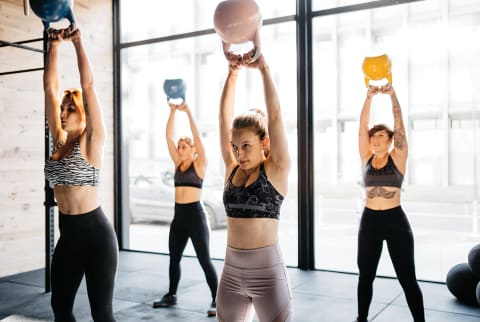Advertisement
5 Mistakes People Make With Group Fitness & How To Actually Get Stronger


Fitness classes hold a long-standing spot on many women's calendars. We have our favorite studios, our favorite instructors, and our favorite classmates to commiserate with. And the foundation of group fitness is movement plus community—which research shows to have a pretty impressive impact on your mental and physical health1.
But even if you attend three, five, or even seven classes a week, those physical benefits seem to wane with time or even stall at the starting gate. It's frustrating (I've been there).
So I tapped two fitness experts on the most common mistakes they see people make when it comes to group fitness and how to finally push past the plateau to finally feel stronger, leaner, toned, or more confident:
Overdoing it on "high-intensity" classes
Boot camps, spin, circuit training, Tabata, and kickboxing are all popular "high-intensity" classes. They're supposed to get your heart rate up and have the potential to help you burn fat and build muscle2 efficiently (when programmed correctly of course).
But exercise physiologist and sports nutritionist Alyssa Olenick, Ph.D., sees things go awry when women start going overboard on these classes. "Doing 5-6 days a week of 'higher intensity' work can make it so that nothing is high intensity anymore—it kind of all meshes into moderate intensity," she says.
Overall, this type of routine is the perfect recipe for picking up the same weights day after day or telling yourself you can't give it your all during the workout because you have to do it all again tomorrow.
In addition, "It also doesn't 'polarize' or 'balance' easy and hard work or allow space for recovery or other types of fitness," Olenick notes.
The solution? Keep high-intensity workouts in your routine, but you don't need to do them daily. Allow yourself time to recover and to participate in other types of training.
Not mixing up training methods
And that's the next biggest pitfall: not mixing up training methods.
"Sometimes we fall in love with a particular style of movement, or studio—which is great. But at some point, your body will start to adapt to that movement style, and it will no longer push you the same way it did when you first started," says instructor and co-owner of a fitness studio Thalia Bardell.
Olenick recommends incorporating longer-duration slower cardio sessions (walking or zone 2 training are some examples), or slower, heavier strength training to your routine alongside your favorite group fitness classes.
Or, if you're strictly a group fitness person, you can find this variety in the classes you take—with the right amount of planning.
"For those who struggle with cardio, try adding a HIIT, indoor cycling, or running class into your routine two days a week," says Bardell.
And for all the cardio fanatics out there? "Adding two to three days of strength training a week through a strength class can make a huge impact on your physical health; trying something like a strength class, barre, or reformer style Pilates would be a great way to vary up your training and continue to see results," says Bardell.
Not lifting heavy enough
Results will also plateau if the weights that you're lifting plateau—as a certain amount of stress, tension, and even muscle damage is needed for muscle growth. And more and more weight is eventually needed to keep driving those beneficial changes.
"If you've been using the same weights for over a year in your barre or strength classes, it's time to level up," says Bardell. "Because what's the worst that can happen? You go back to what you were lifting before? It's not that big of a risk."
To lift heavier, Olenick emphasizes the importance of moving slower through the exercises. "Instead of moving weight around quickly, think about going slower in these classes so you will do fewer reps during the set time."
Many of us are conditioned to think that moving faster is better when it comes to exercise. But that's not the case when it comes to heavy lifting. Opt for a class or two a week that prioritizes a heavy but slow philosophy, or head to the weight room for formal lifting days between your favorite classes.
Relying on the class to do all the work
"Another barrier to seeing results in group fitness is that we often rely on the class itself to do most of the work in terms of challenge," says Bardell. And while actually making it to the class is often considered one of the biggest hurdles, just showing up and going through the motions isn't enough to incite change.
"The magic of group fitness really happens when you push yourself within the parameters of the class," says Bardell. "If the class itself is challenging and then you bring a physical and mental energy of stepping out of your comfort zone, you will continue to see results."
It's truly a team effort between you and the class.
Underconsuming protein & carbs
Lastly, not fueling adequately can hinder your progress (and recovery) from fitness classes.
Olenick sees many women not eating the protein and carbs (and even calories) to support the intensity and volume of training.
And most women need a lot more protein than we think (we dive deeper into that topic here)—typically a minimum of 100 grams a day.
Like strength training, dietary protein stimulates muscle protein synthesis—which is needed to both maintain and increase your lean body mass.
Earlier this year, I started a two-week experiment where I upped my protein intake from 60 to 100 grams a day, and I felt more energized, stronger, and like I could push myself much harder during my workouts. Needless to say, I'm still on the high-protein bandwagon.
The biggest physical difference I felt, though, was once I started taking a creatine supplement. Creatine has long been a popular choice for gym bros, but it's important for women too. Creatine helps increase the energy supply in your muscles and promote efficient recovery, meaning you are more prepared to take on your next class. It also increases lean muscle
Carbs are also vital to improving your fitness. Glucose is the main source of fuel for our cells, and you'll feel the downsides almost immediately during a workout (especially for high-intensity or aerobic training) if you don't have enough on hand.
Olenick emphasized in a recent mindbodygreen podcast episode that carbs aren't the enemy and are very much needed as part of a strength-supporting diet.
The takeaway
Group fitness is a great way to stay active, form friendships, and get stronger. But it's easy to get comfortable with your routine and then see progress stagnate.
While you can (and should!) keep going to your favorite classes, make sure you're also mixing up your training methods and picking up those heavy weights.
And if you're nervous? Remember that you have a built-in community for support with classmates who have the same goal.
Watch Next
Enjoy some of our favorite clips from classes
Enjoy some of our favorite clips from classes
What Is Meditation?
Mindfulness/Spirituality | Light Watkins
Box Breathing
Mindfulness/Spirituality | Gwen Dittmar
What Breathwork Can Address
Mindfulness/Spirituality | Gwen Dittmar
The 8 Limbs of Yoga - What is Asana?
Yoga | Caley Alyssa
Two Standing Postures to Open Up Tight Hips
Yoga | Caley Alyssa
How Plants Can Optimize Athletic Performance
Nutrition | Rich Roll
What to Eat Before a Workout
Nutrition | Rich Roll
How Ayurveda Helps Us Navigate Modern Life
Nutrition | Sahara Rose
Messages About Love & Relationships
Love & Relationships | Esther Perel
Love Languages
Love & Relationships | Esther Perel












